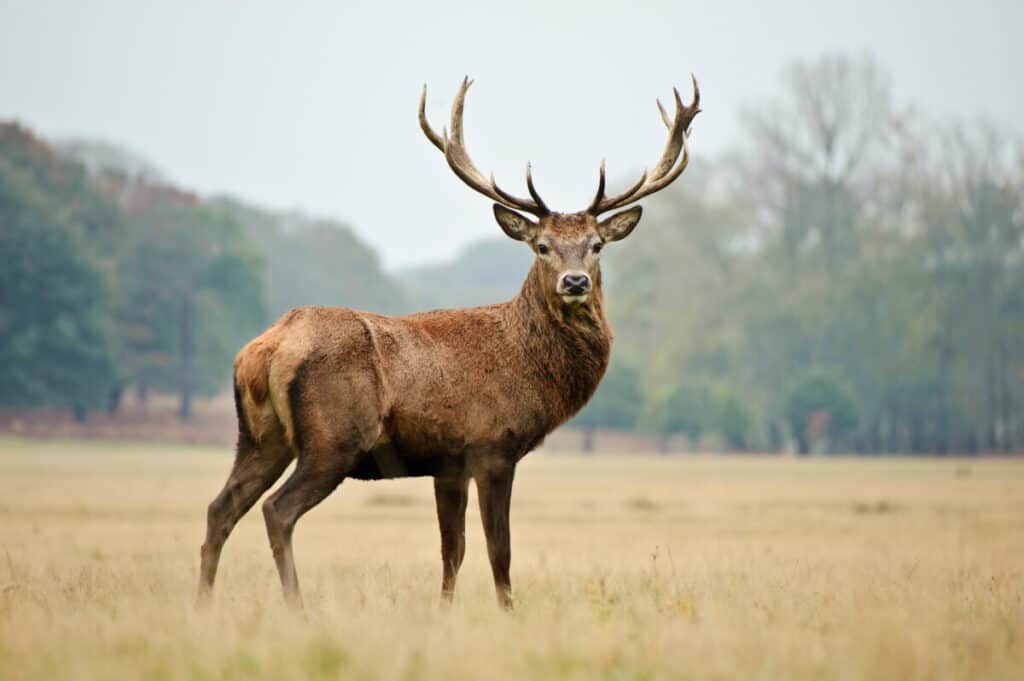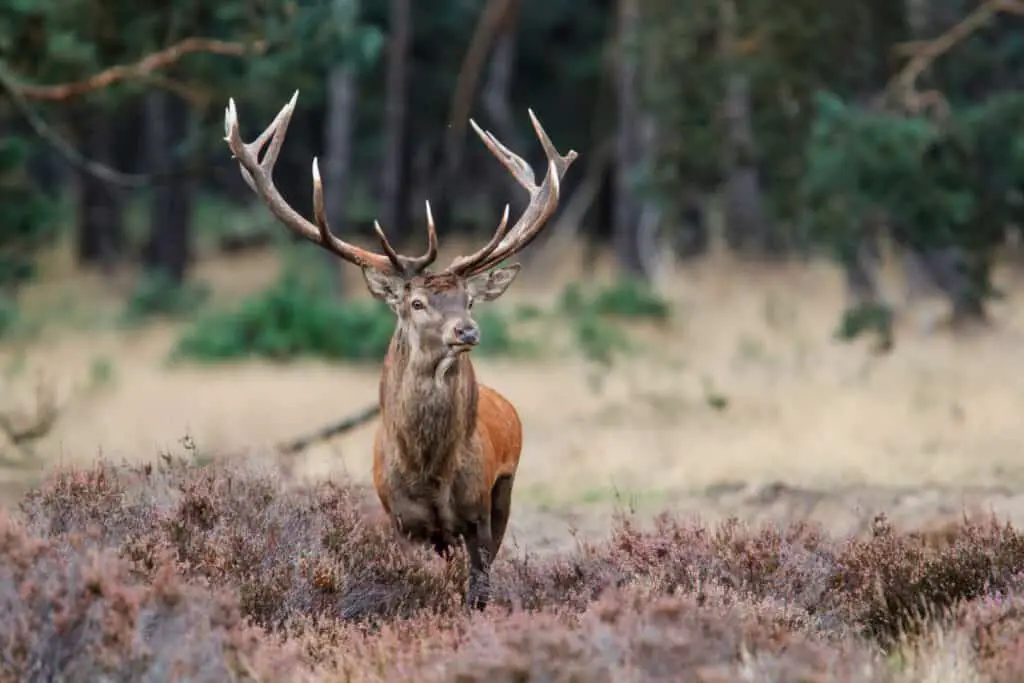The red deer (Cervus elaphus) is a large mammal found in various parts of the world, including Europe, Asia, North Africa and New Zealand. It belongs to the family Cervidae which includes other species such as moose, elk and reindeer.
Red deer are known for their impressive antlers which can grow up to 1 meter long and weigh around 5kg.
Red deer have a significant cultural importance in many societies due to their association with hunting and sport. They are also valued for their meat which has been consumed by humans for centuries.
Despite this, red deer populations have faced numerous challenges over time including habitat loss, poaching and climate change. Understanding the ecology and behavior of these animals is crucial for effective conservation efforts aimed at preserving their population numbers.
This article will provide an overview of the physical characteristics, distribution, behavior and threats facing red deer populations globally.

Physical Characteristics Of Red Deer
Red deer (Cervus elaphus) is a species of large-sized mammal in the family Cervidae. They are known for their impressive size variations, as males can weigh up to 300kg and stand at shoulder heights of around 1.5m, while females are typically smaller and lighter.
Additionally, red deer have a distinctive coat coloration that varies from reddish-brown to grayish-brown depending on the season.
One of the most notable physical characteristics of male red deer is their antler development. Antlers are bony outgrowths from the skull that start growing in early spring each year and shed in late winter or early autumn. The size and complexity of antlers depend on various factors such as age, genetics, nutrition, and social status.
Generally speaking, older males tend to have larger and more elaborate antlers than younger ones since they’ve had more time to accumulate nutrients necessary for growth over multiple years. Moreover, antlers play an important role in inter-male competition during mating seasons by serving as weapons used to fight off rivals and establish dominance over potential mates.
Global Distribution Of Red Deer
As discussed in the previous section, red deer have a unique set of physical characteristics that help them survive in their environment. Their muscular build and large antlers allow them to compete for resources such as food and mating opportunities. However, habitat preferences also play a crucial role in determining the distribution of red deer populations.
Red deer are found across Europe, Asia, North Africa, and even parts of South America. They typically prefer open grasslands or forests with clearings, but can also be found in mountainous regions up to 3,000 meters above sea level.
During winter months, they may migrate to lower elevations for easier access to food sources such as shrubs and buds. Additionally, some herds will migrate long distances between summer and winter ranges to take advantage of seasonal changes in vegetation availability.
Understanding these migration patterns is important for conservation efforts aimed at protecting red deer populations from overhunting or loss of suitable habitat.
Behavioral Patterns Of Red Deer
Dominance hierarchy is an important aspect of red deer social behavior. Young males often engage in physical fights to establish dominance over others. The winner gains access to resources such as food, water, and mating opportunities. Dominant males can mate with multiple females during the breeding season while subordinate males may not get a chance to mate at all.
Mating behavior in red deer is complex and involves several stages. During the rutting season, which typically occurs in autumn, male red deer compete for females by displaying their antlers and vocalizing loudly. Females select mates based on various factors including age, size, and overall health. Once a pair has formed, they will remain together until the end of the breeding season.
Male red deer do not provide any parental care after mating and offspring are raised solely by the mother.
Threats To Red Deer Populations
What are the threats to red deer populations?
Unfortunately, human interference and habitat loss are two major factors contributing to their decline. As humans continue to expand into previously wild areas, they bring with them pollution, noise, hunting practices, and other disturbances that disrupt the natural balance of ecosystems and put wildlife at risk.
Additionally, land development for agriculture or urbanization often results in destruction or fragmentation of habitats essential for red deer survival.
The following list outlines some specific examples of how human activity is threatening red deer populations:
- Overhunting
- Habitat degradation due to logging
- Road construction leading to habitat fragmentation and increased mortality rates from traffic accidents
- Poaching
These ongoing threats require immediate attention if we hope to preserve these magnificent animals for future generations.
It is crucial that conservation efforts prioritize minimizing human impact on natural environments while also ensuring sufficient protected areas for red deer to thrive.
Conservation Efforts For Red Deer
Conservation efforts for red deer have been implemented in various ways, including hunting regulations and habitat restoration efforts. Hunting regulations are often put into place to control the population size of red deer in certain areas where they may cause damage to crops or pose a threat to human safety. In many countries, such as Scotland and New Zealand, hunting seasons are established with limits on the number of animals that can be taken by hunters. This helps ensure that the red deer population remains sustainable while also allowing for recreational hunting opportunities.
In addition to hunting regulations, habitat restoration efforts have also been employed to conserve red deer populations. These efforts involve restoring natural habitats that were previously destroyed due to human activities such as deforestation or agricultural expansion. By restoring these habitats, it provides suitable living conditions for red deer and other wildlife species to thrive in their natural environment. Examples of habitat restoration projects include reforestation initiatives, wetland restorations, and conservation grazing programs that promote biodiversity within ecosystems.
| Hunting Regulations | Habitat Restoration Efforts |
|---|---|
| Establishing hunting seasons | Reforestation initiatives |
| Limits on number of animals hunted | Wetland restorations |
| Sustainable population management | Conservation grazing programs |
| Recreational hunting opportunities | Promoting biodiversity within ecosystems |
It is important for conservationists and policymakers to continue implementing strategies for protecting the red deer species through measures like hunting regulations and habitat restoration efforts. Through collaborative efforts from all stakeholders involved, we can work towards preserving this iconic animal’s future existence while also promoting sustainable land use practices. By doing so, we contribute towards maintaining ecological balance not only for present generations but also for those yet unborn.
Cultural Significance Of Red Deer
The red deer has long been a culturally significant animal in many parts of the world. Traditional beliefs surrounding this majestic creature vary widely across different cultures and have given rise to numerous myths, legends, and folklore.
In some societies, the red deer is considered sacred or even divine, with stories associating it with various gods and goddesses. For instance, in Celtic mythology, Cernunnos was often depicted as a horned god associated with fertility and hunting who was said to be accompanied by a herd of stags.
Hunting practices related to red deer have also played an important role in cultural traditions worldwide. Throughout history, people have hunted these animals for food, clothing, and other resources such as antlers which were used for decorative purposes. Hunting rituals involving the red deer varied from place to place but often involved elaborate ceremonies that honored both the hunter and the prey.
Some Native American tribes believed that killing a red deer required asking permission from its spirit beforehand while others performed intricate dances before setting out on a hunt. As such, the cultural significance of the red deer transcends simple practical considerations like sustenance or shelter – instead reflecting deep-seated human attitudes towards nature itself.

Conclusion
The red deer is a majestic creature that symbolizes strength, resilience, and adaptability. Its physical characteristics are impressive, with males growing antlers up to one meter in length. The species has a global distribution, inhabiting areas from Europe to Asia and North Africa. Red deer have shown remarkable behavioral patterns such as territoriality and seasonal migration.
Despite their robustness, red deer populations face various threats including habitat loss and hunting. As a result, conservation efforts for this species have been implemented worldwide. These include habitat restoration programs and restrictions on hunting practices.
Red deer holds significant cultural significance across many cultures throughout the world. They feature prominently in folklore, literature, music, art, and even national symbols. This highlights how deeply ingrained they are in human history.
In conclusion, the red deer’s symbolism goes beyond its physical attributes or geographic range; it embodies qualities that humans admire – tenacity, courage, and endurance against adversity.
Without proper conservation efforts in place globally, these noble creatures may not be able to continue thriving as an integral part of our planet’s biodiversity. Therefore we must acknowledge their importance and work towards preserving them for future generations to appreciate their symbolism fully.
